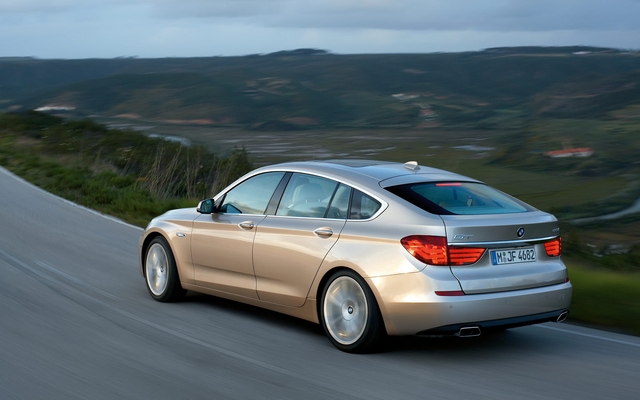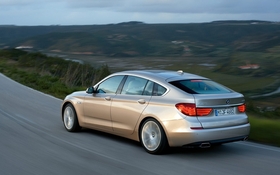2010 BMW 535i xDrive GT: The Hunback of Bavaria!

| Strong points |
|
|---|---|
| Weak points |
|
There’s a saying amongst seafaring folks that goes like this: life is too short to own an ugly boat. Now, these people are typically of the same sort that shop at places like Harry Rosen, go to work in John Varvatos suits, and drive Bentleys… or BMWs. So why on Earth did BMW make something that looks like this?
Because it is undeniably, unquestionably, uncharacteristically ugly in a way that hasn’t really been seen since Honda channeled their inner Aztek with the Accord Crosstour. In fact, to call something that looks like this the 5-series “GT” is nothing short of false advertising. GT, or Grand Touring (or Gran Turismo), typically conjures up images of luxurious Bentleys, svelte Astons, supercharged Jags, and pavement-rippling V12 Mercedes coupes… not something that looks like it would be more at home in a belltower. Perhaps BMW should have called it the Hunback.
But what’s perhaps most surprising is that, beneath the controversial skin, is none other than the much-lauded 5-series platform… but that doesn’t mean it’s exactly the same. You see, BMW’s current crop of 5, 6, and 7-series vehicles ride on a modular platform that allows for much variation between the different models. As a result, the 5-series GT is actually a wee bit bigger than the standard 5-series sedan, with a footprint that apes that of the larger 7-series sedan. However, the dynamic benefits of that added length and width is offset by the car’s 4.3” taller stance; a figure that’s made even more suspect by the fitment of 18” wheels and relatively tall 245/50R18 tires as standard equipment. Of course, under the hood, the latest 3.0L, turbocharged, inline six still spins out the same 300 horsepower and 300 pound-feet of torque as you’ll find motivating a 535i sedan.
Put it all together, and if I’m honest, you get a car that bears only a passing resemblance to the standard 5-er. The longer wheelbase does improve the ride slightly, but also has a numbing effect on the typically quick steering. And although the added width should help it feel that much more stable in the corners, the tall tires and airy ride height conspire against the best efforts of the adaptable suspension system, yielding a car that feels softer, mushier, and much less eager to respond to inputs.
Of course, that is generally what happens when you tack an additional 700 or so pounds onto a car. Yes, you read that right. Coming in a whopping 4,706 pounds, the lightest available 5-series GT (the same 535i xDrive GT I tested, for the record) tramples all over the standard 5-series’ curb weight like a hungry, hungry hippo headed for a feeding frenzy. In fact, that same base level 535i xDrive GT is actually a heavier vehicle than even the range-topping, twin-turbo V8-powered 750i! But while the svelte 5-series sedan and Teutonic 7-series carry their weight quite well, the GT is one of those bizarre front-engined, rearward-weight-biased vehicles, carrying 53% of its total weight over the rear axle. Combine that with the active all-wheel drive system that’s standard on all GTs, and you get a pretty different version of BMW’s driving dynamics than most will be accustomed to.
But there’s a reason why there’s so much weight back there. Recognizing a need for a 5-series with more rear-seat legroom, the 5-series GT’s rear seat is actually more akin to that found in the 7-series, with fantastic space available in every dimension, and a nifty two-rear-seats-only package that installs a centre console and dramatically ups the luxury quotient with things like available electric sun shades for the side windows and rear-seat entertainment systems. Out front, things are pretty much standard 5-series fare, and that’s definitely a compliment.
And of course, being a hatchback, there is an added degree of practicality. But the cargo configuration is a bit different than you’re likely to see in other vehicles. First off, there’s the hatch, which is quite normal in it's operation, but actually integrates a tailgate as well. Quickly pressing the trunk release on the fob, the interior trunk release, or one of two rubberized buttons on its underside releases the relatively miniscule and incredibly vertical trunk opening. Conversely, holding the fob button or selecting the right-hand rubberized button releases the much more substantial motorized hatch. Given my druthers, I tried to avoid the awkwardly shaped and hard to access trunk opening, and still struggle with BMW’s logic in including it. After all, anything that you can slide in and out of the trunk’s oversized mail slot will also fit through the cavernous and easier to access hatch opening… so why not just opt for the hatch and do away with the bulky and probably heavy dual-opening system? Likewise, there’s a bit of strangeness about the rear-seat pass through. While most manufacturers simply use the rear seat backs to separate the trunk space from the cabin, BMW has installed a secondary rear trunk wall. That means longer items require that both the seat, and the corresponding rear trunk wall be folded down. Now, this part isn’t as crazy; that rear trunk wall serves to both insulate the cabin further, and gives a nice flat load floor when it’s properly used… but it’s still a little weird.
Yes, a little weird, indeed. Maybe that’s the best way to describe this car… not just its trunk, but the whole thing. Part 7-series, part X6, but 5-series in name, it’s an anachronism, which isn’t something BMW is known for producing. Then again, maybe we just think that. After all, although considered one of the most Germanic of brands in style, precision of engineering, and perfection of execution, they have a pretty decent track record for churning out some real strange automobiles. And although this may not quite rank up there with dropping doors of the Z1 sports car, it definitely trumps the original, then-controversial Z3 coupe. Let’s just hope that the Hunback of Bavaria manages to find a few more buyers than either of those.











